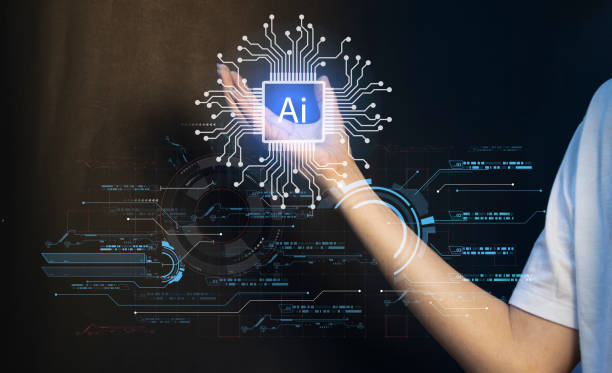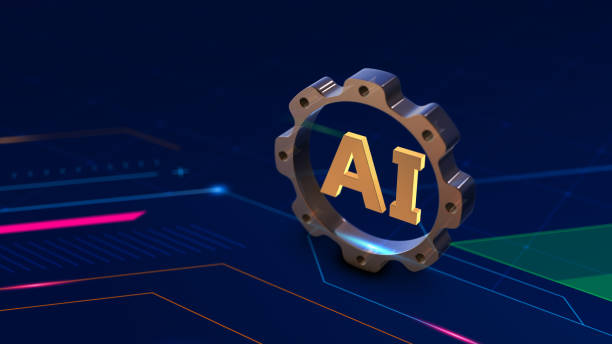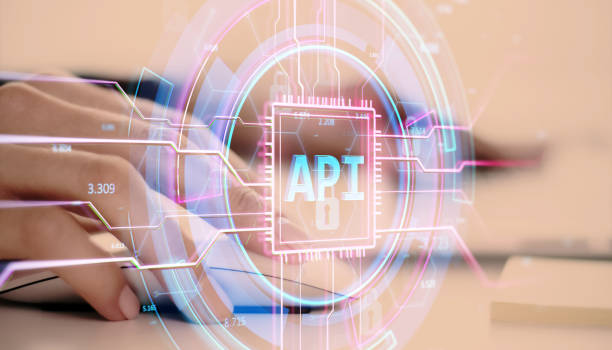What is Artificial Intelligence? Definition and Basic Concepts

#Artificial_Intelligence (AI), in short, is a branch of computer science that deals with building machines capable of performing tasks that usually require human intelligence.
These tasks include learning, problem-solving, decision-making, pattern recognition, natural language understanding, and computer vision.
AI tries to implement these capabilities in the form of algorithms and computational models.
Artificial intelligence is divided into two main categories:
- Narrow AI This type of AI performs well only in a specific domain.
For example, a chess-playing program or a facial recognition system. - General AI This type of AI is capable of performing any task that a human can.
General AI is still in the research stages and has not yet been fully realized.
Key concepts in artificial intelligence include:
- Machine Learning is a method that allows machines to learn from data without explicit programming.
- Neural Networks are models inspired by the structure of the human brain and are used to learn complex patterns and relationships in data.
- Natural Language Processing enables machines to understand and generate human language.
More information - Computer Vision enables machines to understand images and videos.
These basic concepts form the foundation of artificial intelligence, and understanding them is essential for entering this field.
Artificial intelligence is constantly evolving, and new applications are discovered with technological advancements.
Don’t have a company website yet and missing out on online opportunities? With professional corporate website design by Rasawp,
✅ Double your business credibility
✅ Attract new customers
⚡ Free consultation for your corporate website!
History of Artificial Intelligence from Inception to Today

The history of artificial intelligence dates back to the 1950s when scientists and researchers began exploring the possibility of building thinking machines.
One of the early milestones was the Dartmouth Conference in 1956, which is considered the official birth of AI.
At this conference, pioneers like John McCarthy and Marvin Minsky gathered and defined the goals and challenges of this field.
The 1960s and 1970s saw initial advancements in areas such as problem-solving and logical reasoning.
However, hardware limitations and a lack of data quickly halted these advancements.
This period became known as the “AI winter” as funding and interest in the field declined.
In the 1980s, with the emergence of expert systems and machine learning, AI was revived.
Expert systems were programs that stored specialized knowledge in a particular domain and could act as consultants for humans.
However, expert systems also had limitations and could not fully meet expectations.
The 1990s witnessed significant advancements in areas such as neural networks and deep learning.
New algorithms and increased computational power made it possible to train more complex models.
These advancements led to practical applications in fields such as facial recognition, machine translation, and speech recognition.
Today, artificial intelligence is widely used in various industries, including medicine, finance, manufacturing, and transportation.
With continuous advancements in areas such as deep learning, natural language processing, and computer vision, AI is expected to play an even more significant role in the future.
Artificial intelligence has increasingly permeated our daily lives and has the potential to change the world.
Applications of Artificial Intelligence in Various Industries

Artificial intelligence has widespread applications in various industries and is increasingly transforming.
Below are some important applications of artificial intelligence in different industries:
- Healthcare AI is used in disease diagnosis, drug development, patient care, and hospital management.
For example, deep learning algorithms can analyze medical images and diagnose diseases with higher accuracy. - Finance AI is used in financial data analysis, market trend prediction, fraud detection, and risk management.
For example, intelligent systems can identify hidden patterns in financial data and suggest investment opportunities. - Manufacturing AI is used in automating production processes, quality control, predicting equipment failures, and optimizing the supply chain.
For example, intelligent robots can perform repetitive and dangerous tasks on production lines. - Transportation AI is used in the development of self-driving cars, optimizing transportation routes, managing traffic, and improving road safety.
For example, autonomous systems can safely and efficiently guide vehicles using sensors and intelligent algorithms.
More information - Customer Service AI is used in providing customer service, answering customer questions, offering personalized suggestions, and resolving customer issues.
For example, intelligent chatbots can answer customer questions 24/7.
These are just a few examples of artificial intelligence applications in various industries.
With technological advancements, new applications for AI are expected to be discovered, and this technology will play an increasingly important role in the global economy.
Artificial intelligence helps companies increase their productivity, reduce costs, and offer better products and services.
| Industry | AI Application |
|---|---|
| Healthcare | Disease Diagnosis |
| Finance | Fraud Detection |
| Manufacturing | Process Automation |
| Transportation | Development of Self-driving Cars |
Machine Learning: The Beating Heart of Artificial Intelligence

Machine Learning is one of the main subfields of artificial intelligence that enables machines to learn from data without explicit programming.
In fact, instead of the programmer directly defining rules and algorithms for the machine, the machine uses machine learning algorithms to identify patterns and relationships in the data and makes decisions based on them.
Machine learning is divided into three main categories:
- Supervised Learning In this type of learning, the machine is trained using labeled data.
This means that for each input, the desired output is also specified.
The goal is for the machine to predict correct outputs for new inputs based on the training data. - Unsupervised Learning In this type of learning, the machine is trained using unlabeled data.
The goal is for the machine to identify hidden patterns and structures in the data. - Reinforcement Learning In this type of learning, the machine learns how to behave to receive the most reward by interacting with the environment and receiving rewards or penalties.
Machine learning algorithms are diverse and are selected based on the type of data and the problem’s objective.
Some common algorithms include:
- Linear Regression
- Logistic Regression
- Decision Tree
- Support Vector Machine
- Neural Networks
Machine learning plays a very important role in the development of artificial intelligence and is used in many practical applications.
Artificial intelligence cannot fully develop and reach its true potential without machine learning.
Do you know that a weak corporate website loses you many opportunities daily? Solve this problem forever with professional corporate website design by Rasawp!
✅ Create a powerful and trustworthy image for your brand
✅ Attract new customers purposefully and increase sales
⚡ [Receive Free Website Design Consultation]
Neural Networks and Deep Learning: Modern Approaches to Artificial Intelligence

Neural Networks are models inspired by the structure of the human brain and are used to learn complex patterns and relationships in data.
A neural network consists of many interconnected nodes (neurons).
Each node receives an input, processes it, and produces an output.
The output of each node is used as input for other nodes in the network.
Deep Learning is a subfield of machine learning that uses deep neural networks (neural networks with many layers).
Deep neural networks are capable of learning very complex patterns in data and often perform better than traditional machine learning algorithms in many applications.
Neural networks and deep learning have applications in various fields such as computer vision, natural language processing, speech recognition, and computer games.
For example, deep neural networks can recognize images with high accuracy, translate different languages, and defeat humans in complex games like Go.
Some well-known neural network architectures include:
- Convolutional Neural Networks are used for processing images and videos.
- Recurrent Neural Networks are used for processing sequential data such as text and audio.
- Generative Adversarial Networks are used to generate new data similar to the training data.
Neural networks and deep learning, as modern approaches to artificial intelligence, are transforming various industries and are expected to play a more significant role in our lives in the future.
Artificial intelligence, using these approaches, will be able to solve more complex problems.
Challenges and Limitations of Artificial Intelligence

Despite significant advancements, artificial intelligence still faces challenges and limitations.
Some of these challenges include:
- Need for Large Amounts of Data Machine learning algorithms, especially deep neural networks, require a large volume of data for training.
Collecting and labeling this data can be costly and time-consuming. - Interpretability Some AI models, such as deep neural networks, are difficult to interpret.
This can reduce trust in these models and become problematic in applications requiring transparency and explainability. - Bias If training data is biased, AI models will also be biased.
This can lead to unfair and discriminatory decisions. - Security AI systems can be vulnerable to cyberattacks.
For example, attackers can manipulate training data or deceive AI models. - Ethical Issues Artificial intelligence can raise serious ethical issues, such as privacy, accountability, and employment.
To overcome these challenges, further research is needed in areas such as learning with limited data, model interpretability, bias reduction, AI security, and AI ethics.
Artificial intelligence must be developed in a way that is safe, fair, and reliable.
The Future of Artificial Intelligence

The future of artificial intelligence is very bright and full of potential.
AI is expected to play a more significant role in our lives in the coming years and bring about remarkable transformations in various industries.
Some important trends in the future of artificial intelligence include:
- Explainable AI Developing AI models that are understandable and interpretable.
- Responsible AI Developing AI that is ethical, fair, and safe.
- Edge AI Running AI algorithms on edge devices such as smartphones and self-driving cars.
- AutoML Automating the process of developing AI models.
- Hybrid AI Combining different AI methods to solve complex problems.
In the future, artificial intelligence will be able to automate many tasks and assist humans in their work.
This can lead to increased productivity, reduced costs, and improved quality of life.
However, to harness the full potential of AI, its challenges and limitations must also be considered, and its ethical implications addressed.
| Trend | Description |
|---|---|
| Explainable AI | Development of understandable models |
| Responsible AI | Development of ethical and safe AI |
| Edge AI | Running AI on edge devices |
| AutoML | Automation of model development |
How to Learn Artificial Intelligence

Learning artificial intelligence can be an exciting and rewarding journey.
To start, you can use various resources such as online courses, books, articles, and practical projects.
Below are some useful tips and resources for learning artificial intelligence:
- Learn basic concepts of mathematics and computer science For a deep understanding of AI, you need foundational knowledge in mathematics (such as linear algebra, calculus, and statistics) and computer science (such as algorithms and data structures).
- Learn relevant programming languages Python is one of the most popular programming languages for AI.
Also, other languages like R and Java are used in some applications. - Follow online courses Educational platforms like Coursera, edX, and Udemy offer a variety of AI courses.
These courses can help you learn basic concepts and advanced AI algorithms. - Read relevant books and articles There are many books and articles on AI that can help you gain a deeper understanding of this field.
- Do practical projects The best way to learn AI is by doing practical projects.
You can train AI models using available data and evaluate the results. - Participate in online AI communities There are many online forums and groups dedicated to AI where you can participate and connect with other enthusiasts in this field.
Learning artificial intelligence requires patience and perseverance.
With effort and practice, you can gain skills in this field and become an AI specialist.
Artificial intelligence is a dynamic and growing field, so you should always be looking to learn new things.
Are you worried about your e-commerce site’s low conversion rate and not achieving your desired sales?
Rasawp is your specialized solution for a successful e-commerce website.
✅ Significant increase in conversion rates and sales
✅ Professional and user-friendly design to attract customer satisfaction
⚡ Ready for a revolution in online sales? Get a free consultation!
Artificial Intelligence in Iran: Status and Outlook

Artificial intelligence in Iran has also been recognized as an important field, and significant progress has been made in this area in recent years.
Many universities and research centers in Iran are active in AI, offering various training courses and research projects.
Some applications of artificial intelligence in Iran include:
- Smart Agriculture Using AI in water resource management, plant disease detection, and increasing agricultural productivity.
- Health and Treatment Using AI in disease diagnosis, providing remote medical services, and hospital management.
- Industry Using AI in automating production processes, quality control, and optimizing the supply chain.
- Services Using AI in providing customer services, answering customer questions, and offering personalized suggestions.
However, artificial intelligence in Iran still faces challenges.
Some of these challenges include:
- Lack of Experts The shortage of skilled professionals in AI is one of the main challenges.
- Lack of Data Access to quality and labeled data for training AI models is limited.
- Financial Constraints There is insufficient budget for research and development in AI.
Despite these challenges, the outlook for artificial intelligence in Iran is bright.
With more investment in education, research, and development, and with cooperation between universities, research centers, and industries, the potential of AI can be utilized for the country’s economic and social development.
Artificial intelligence can play an important role in improving the quality of life for the people of Iran.
Frequently Asked Questions about Artificial Intelligence

In this section, we answer some frequently asked questions about artificial intelligence:
- What is the difference between AI and Machine Learning? Machine learning is a subfield of artificial intelligence.
AI generally refers to building machines with the ability to think, while machine learning enables machines to learn from data without explicit programming. - Will AI replace humans? In some tasks, AI can replace humans.
However, in many other tasks, AI can serve as an auxiliary tool for humans and help them perform tasks. - Is AI dangerous? AI can be dangerous if not developed correctly and if its ethical issues are not addressed.
- How can bias in AI be prevented? To prevent bias in AI, diverse and unbiased training data must be used, and AI models should be regularly reviewed and evaluated.
- Can AI be creative? AI can show creativity in some areas.
For example, AI can compose music, paint, and write stories.
We hope these questions and answers have helped you better understand artificial intelligence.
Artificial intelligence is a complex and fascinating field that is constantly evolving.
Frequently Asked Questions
| Question | Answer |
|---|---|
| What is Artificial Intelligence? | It is the simulation of human intelligence in machines programmed to think like humans and imitate their actions. |
| What are the main branches of Artificial Intelligence? | They include machine learning, deep learning, natural language processing, computer vision, and robotics. |
| What is Machine Learning? | It is a branch of artificial intelligence focused on enabling systems to learn from data and identify patterns without explicit programming. |
| Mention examples of Artificial Intelligence applications in our daily lives. | Voice assistants (like Siri and Alexa), recommendation systems in Netflix and Amazon, self-driving cars, and facial recognition programs. |
| What is Deep Learning? | It is a subset of machine learning that uses multi-layered (deep) artificial neural networks to process large amounts of data. |
| What is Natural Language Processing (NLP)? | It is a branch of artificial intelligence focused on enabling computers to understand, interpret, and generate human language. |
| What are some ethical concerns related to Artificial Intelligence? | These include data bias, privacy, job displacement, and accountability in case of errors. |
| What are the main benefits of Artificial Intelligence? | Increased efficiency, improved decision-making, automation of repetitive tasks, and discovery of complex patterns in data. |
| How is Artificial Intelligence used in healthcare? | In disease diagnosis, drug discovery, medical image analysis, and personalized patient care. |
| How do you see the future of Artificial Intelligence? | It is expected to continue evolving rapidly, impacting all aspects of human life, from industry to education and entertainment. |
And other advertising services from Rasa Web advertising agency in the field of advertising
- Smart Digital Advertising: An effective tool for digital branding by customizing user experience.
- Smart Data Analysis: Designed for businesses looking to analyze customer behavior through Google Ads management.
- Smart Data Analysis: A combination of creativity and technology for online growth through Google Ads management.
- Smart Content Strategy: A new service for increasing customer acquisition through custom programming.
- Smart UI/UX: A professional solution for increasing sales by focusing on attractive user interface design.
And over hundreds of other services in internet advertising, advertising consultation and organizational solutions
Internet Advertising | Advertising Strategy | Advertorials
Resources
What is Analytical AI and How Does it Work?
Applications of Analytical AI in Various Industries
The Future and Challenges of Analytical AI
Practical Guide to Implementing Analytical AI
? For a leap in your business in the digital space, Rasawp Avarin Digital Marketing Agency, specializing in SEO, targeted content marketing, and user-friendly website design, is your guide to success.
📍 Tehran, Mirdamad Street, next to Central Bank, Southern Kazeroun Alley, Ramin Alley, No. 6




